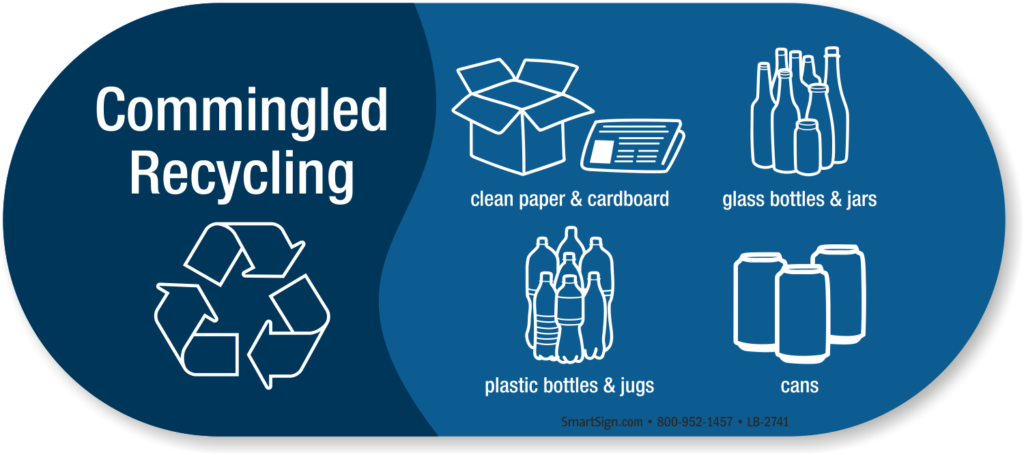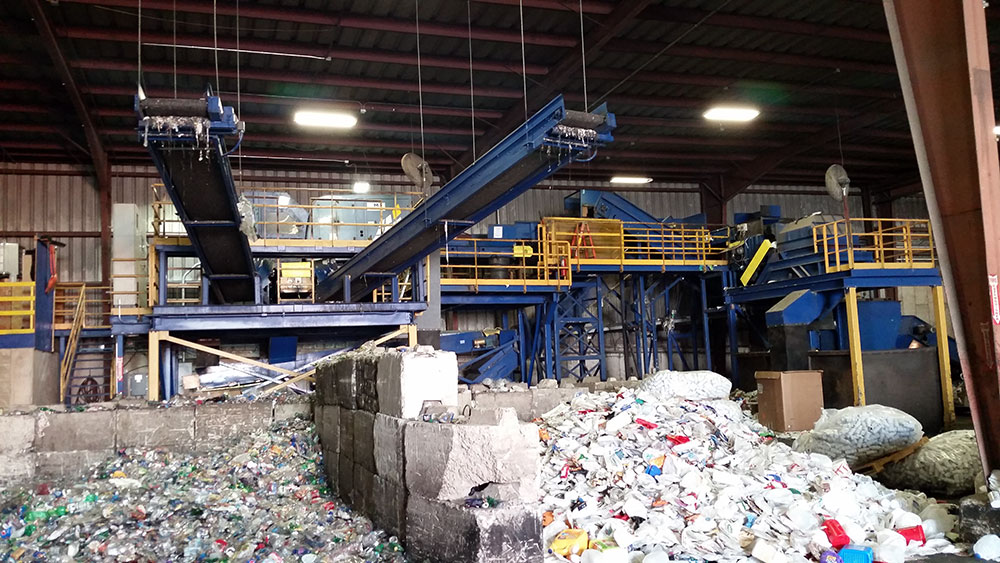
Introduction to Commingled Recycling
Commingled recycling, also known as single-stream recycling, is a system of waste management that allows recyclable materials such as cardboard, paper, and plastic to be placed into one bin or collection truck, instead of requiring separate containers for each type of material. This type of recycling has become increasingly popular with curbside recycling programs in municipalities around the world, as it makes it easier for households to sort their recyclables and reduce their waste heading to landfills. So what is commingled recycling?
What Is Commingled Recycling?
Commingled recycling, or single-stream recycling, is a form of recycling that allows multiple materials to be placed in a single bin and collected from the curbside. This is opposed to dual-stream recycling, which requires separate containers for paper and cardboard and another for plastic, glass, and other materials. With commingled recycling, all materials can be placed in the same bin, where they will be sorted at a Material Recovery Facility (MRF).
This method is becoming increasingly popular in the recycling industry, as it is more efficient and cost-effective than other methods. Commingled recycling is also used to reduce the amount of solid waste that goes to landfill, while at the same time increasing the amount of scrap metal and other materials that can be recycled.
How Commingled Recycling Works?

The process of commingled recycling is fairly simple. All recyclable materials – paper, plastic, metal, and glass – are placed in one bin, which is then taken to a recycling center.
The recycling process begins when items are placed into a single collection truck or curbside recycling bin. From there, the items are transported to a recycling facility to be processed. Once at the recycling facility, the mixed recyclables are placed onto a conveyor belt and transferred onto a series of deck screens.
The deck screens are built with varying sizes of holes, which causes the different materials to be sorted. The larger items—such as cardboard, aluminum cans, and plastic containers—fall through to the bottom screens, while the smaller items, such as broken glass and pieces of paper, are either sorted out or remain in the waste stream. The recyclable materials that fall through to the bottom screens are then processed into new products, while the contaminated materials are diverted to a landfill.
What are the 3 types of recycling?
The three main types of recycling are source separated, commingled, and dual-stream recycling. Source separated recycling is the traditional method of sorting trash into separate containers, such as paper and cardboard in one bin, plastic and glass in another, and aluminum cans in a third. Commingled recycling is a single-sort recycling method where all recyclable items are placed into one bin and then sorted at a recycling facility. Dual-stream recycling is a hybrid of the two, where recyclables are collected in two separate containers—one for paper and cardboard and the other for plastic, glass, and other materials.
Pros and Cons of Commingled Recycling
The primary benefit of commingled recycling is that it doesn’t require households to spend time sorting their recyclables into different containers. This saves time and makes it easier for households to recycle, which can increase diversion rates and help preserve the environment. Additionally, commingled recycling can also reduce collection costs for municipalities and waste management companies, as they don’t have to unload and sort multiple containers of recyclables.
However, commingled recycling is not without its disadvantages. The most significant is the potential for contamination. If items are placed into the wrong bin, or if non-recyclable items, such as dirty paper, greasy pizza boxes, or liquid containers, are mixed into a single collection, it can contaminate the entire load. Contamination can lead to rejected loads, which can increase processing costs and send more waste to landfills.
A disadvantage of commingled recycling is that it is more likely to be contaminated. Since all recyclables are placed into one container, it can be difficult to avoid contamination from non-recyclable materials. This can lead to the recyclables being sent to the landfill instead of being recycled.
What are commingled plastics?

What is an advantage of commingled recycling vs separate containers?
The main advantage of commingled recycling over separate containers is that it saves time and makes it easier for households to recycle. With commingled recycling, households don’t have to spend time sorting their recyclables into different containers. Additionally, it reduces collection costs for municipalities and waste management companies, as they don’t have to unload and sort multiple containers of recyclables.
Is commingled recycling easier?
Yes, commingled recycling is generally easier than source-separated or dual-stream recycling, as it only requires households to place all of their recyclable items into one bin or collection truck. This eliminates the need to sort recyclables into separate containers, which can save time and make it easier for households to recycle.
Is Commingled Recycling Better for the Environment?

When it comes to recycling, commingled bins are becoming increasingly popular. But what exactly are they and why are they better for the environment? We’ll explore the basics of commingled recycling, what can go into the commingled bins, examples of commingled recycling, and how to avoid single-stream contamination.
On the one hand, commingled recycling is beneficial for the environment because it reduces the amount of waste that goes into landfills. By encouraging people to recycle, this type of bin helps divert materials away from landfill and toward recovery facilities. In addition, the materials placed into commingled bins can be sorted more quickly and efficiently at recovery facilities, leading to less waste.
On the other hand, commingled recycling has some drawbacks. One of the main issues is that it leads to more contamination. When materials are mixed, it can be difficult for the sorting machines at recovery facilities to differentiate between them. As a result, unsorted and contaminated materials can end up on the floor of an MRF (Material Recovery Facility), which can lead to materials being sent to a landfill.
In addition, commingled recycling can lead to a decrease in the value of the commodity materials. This is because it is harder to sort through the materials and separate them into their commodities. As a result, the commodities are less valuable, leading to less money for the recovery facilities.
While commingled recycling is beneficial for the environment in some ways, it has some disadvantages. It is important to be aware of these issues so that recycling centers can take steps to reduce contamination and increase the value of the commodities they receive. To do this, recyclers must be careful to include only the materials that are allowed in the commingled bins and to make sure they are placed on a conveyor belt so that they can be sorted and drop through to the bottom of the MRF more easily.
What are Commingled Bins?
Commingled recycling is a type of recycling program where multiple materials are placed into one bin for collection. This bin is usually labeled “commingled” or “mixed recycling”. The idea behind commingled recycling is that it allows for a larger variety of materials to be recycled, which can be more beneficial for the environment.
What Goes into the Commingled Recycling Bin?
Commingled bins are typically used to recycle paper, cardboard, plastic, metal, glass, and aluminum. The types of materials that can be recycled vary by municipality, but the most common materials accepted in commingled recycling bins are newspapers, magazines, cardboard boxes, plastic containers, glass bottles and jars, and aluminum cans.
Examples of Commingled Recycling

Curbside commingled recycling is a popular way to recycle a variety of materials. When you place your commingled recycling into the curbside bin, it is collected by a truck and taken to a facility where it is sorted. At the facility, the materials are separated into different categories so they can be recycled and made into new products.
Another example of commingled recycling is drop-off centers. At these centers, you can place your commingled recycling in a single container. The materials are then taken to a recovery facility where they are sorted and recycled.
Commingled recycling can be used to collect and process the materials in the following categories:
- Paper products, including newspapers, office paper, magazines, and cardboard (Paper is separated into newsprint, cardboard, and other paper)
- Plastic, including beverage containers and other containers
- Aluminum, including cans and foil
- Glass, including glass bottles and jars
- Textiles, including clothing and other fabric
- Metals, including steel and aluminum
- Used food, such as cooked food and vegetable scraps
More Definitions of Commingled Recycling
In addition to curbside and drop-off centers, there are also commingled bins in certain business locations. These bins are typically placed in places like offices, universities, and grocery stores. The materials from these bins are collected and taken to a recovery facility.
Commingled recycling is a process of collecting, sorting, and processing multiple types of materials for recycling. These materials are collected in commingled bins and then transported to a recovery facility. At the facility, the materials are sorted and then sent to specialized processors for further recycling.
The recycled product can then be used as a new product or pick-up.
How to Avoid Single-Stream Recycling Contamination
Single-stream recycling works great for collecting and sorting recyclables, but it can also be a source of contamination. To avoid contamination, be sure to place only clean, dry items into the commingled bins. This means that no food waste or other contaminants should be placed in the bins.
When commingled recycling is collected, it is important to avoid contamination. Contamination occurs when items that cannot be recycled are placed in the bin. Examples of items that should not be placed in the commingled recycling bin include things such as broken glass, hazardous materials, and food waste.
Commingled Recycling Tips
- When recycling commingled materials, it is always best to follow your local municipality’s recycling guidelines. For example, some municipalities may only accept certain types of materials in their commingled recycling bins.
- Additionally, it is important to separate heavier items, such as glass and metal, from lighter items, such as paper and cardboard.
- Once the items are sorted, they are sent to the appropriate recycling facility where they will become new products.
- URM’s commingled recycling bins at your home, office or work site make it easier than ever to recycle plastic, aluminum, steel, and glass containers.
Warnings
- When placing items into a commingled recycling bin, it is important to ensure that the items are clean and dry.
- Additionally, items should not be placed in plastic bags as these can cause contamination.
Conclusion
Commingled recycling is a great way to recycle a variety of materials. By using commingled bins, you can help reduce the amount of waste sent to landfills, create new products from recycled materials, and help create an eco-friendly environment. The increased volume of recyclable waste being collected diverts more waste from landfill. When recycling commingled materials, it is important to follow your local municipality’s recycling guidelines and avoid contamination. With proper recycling practices, commingled bins can be an effective way to keep waste out of landfills and create new products from recycled materials.

